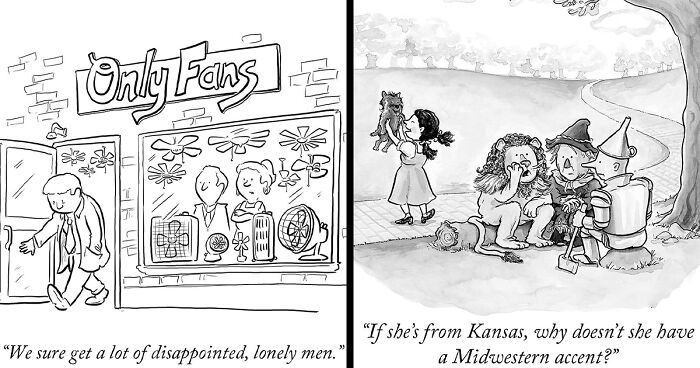
### The Underrated Craft of Single-Panel Comics: A Condensed Artistic Expression
In recent decades, comics have ascended in cultural and scholarly appreciation, firmly positioning themselves as a vital art form that entwines narrative with visual innovation. Once regarded as trivial entertainment, the medium has garnered greater respect, particularly within the spheres of graphic novels and serialized comic strips. Nonetheless, one format remains largely overlooked and inadequately analyzed despite its notable cultural significance: the single-panel comic.
In her latest publication *Singular Sensations: A Cultural History of One-Panel Comics in the United States,* Professor Michelle Ann Abate from The Ohio State University delves into the history, impact, and worth of single-panel comics, advocating for their artistic and intellectual value. From *The Family Circus* to *Ziggy*, *The Far Side*, and *The New Yorker* cartoons, these singular-image formats demand recognition for their cleverness, humor, and frequently sharp commentary. What unfolds in Abate’s work is a reminder that single-panel comics should not be overlooked as basic or intellectually feeble but celebrated as an intensely focused method of storytelling.
—
### Single-Panel Comics: Beyond Appearances
Single-panel comics frequently face the notion that they are too basic to deserve serious critical consideration. As Abate highlights, popular comics such as *The Family Circus* and *Little Lulu*—recognized for their tidy, straightforward designs and humor rooted in slapstick or wordplay—are commonly regarded as unsuitable for in-depth examination. “There’s a prevalent assumption that you don’t require much critical thought to appreciate *Little Lulu* slipping on a banana peel and grasp the punchline,” states Abate. This perception has led to the diminished acknowledgment that single-panel comics usually receive in both mainstream culture and scholarly circles.
However, as Abate’s investigations disclose, there is far more happening within these panels than initially perceived. Even comics like *Ziggy*, often viewed as overly simplistic, provide insightful reflections on everyday existence. According to Abate, *Ziggy* was pioneering in depicting the minor, sometimes absurd challenges of adulthood. “Even before we had a term for ‘adulting,’ *Ziggy* was delving into the mundane irritations of daily life—the type of humor that continues to resonate,” she remarks. Rather than being merely superficial, these comics connect with universal human experiences, often in a subtly relatable manner.
—
### *The Far Side*: A Transformative Force for Nerd Culture and Visual Innovation
If any single-panel comic encapsulates the depth and eccentricity that the format can offer, *The Far Side* by Gary Larson stands out. Abate underscores that *The Far Side* not only defied norms regarding content but also expanded aesthetic boundaries in ways that continue to shape modern comics.
Much of *The Far Side’s* humor revolved around “nerdiness” long before geek culture gained mainstream traction. Featuring middle-aged scientists and socially awkward kids, *The Far Side* embraced characters typically marginalized in popular culture. “When Larson began in 1980, nerdiness was not the celebrated theme it is in today’s media,” notes Abate, “yet *The Far Side* thrived on it.” With its scientific humor, absurdist views on nature, and deadpan style, Larson’s work fostered a space where eccentricity and intellect were appreciated.
However, what genuinely differentiated *The Far Side* was not merely the quirky humor but the visual approach Larson adopted. His characters—often bizarre, tall, and socially inept—challenged conventional beauty ideals in comics. As one critic observed, “Larson’s characters are grotesque.” Abate clarifies that this grotesqueness was intentional and significant: “In Larson’s series, no child was depicted as adorable, no man was portrayed as handsome, and no woman was shown as beautiful by societal standards. The unusual portrayals of human figures actually reinforced the themes within the comic panels.” Through visual simplicity—and even unattractiveness—Larson encouraged readers to engage thoughtfully with the imagery and its implications.
Indeed, Abate contends that Larson’s stylistic impact has left a lasting imprint on cartooning and webcomics. Contemporary series like *The Oatmeal* and *Hyperbole and a Half* reflect Larson’s influence in the way their human characters are illustrated—often awkwardly, frequently exaggerated, and distinctly flawed. Larson’s visual approach departed from traditional aesthetics, establishing fertile terrain for future cartoonists to welcome imperfection and channel it into both humor and insight.
—
### The Art of Condensation: Single-Panel Comics as a Fusion of Literature and Visual Expression
The allure of single-panel comics resides in their capacity to encapsulate an entire narrative, concept, or joke within one image—including both the punchline and setup at once. As Abate succinctly states